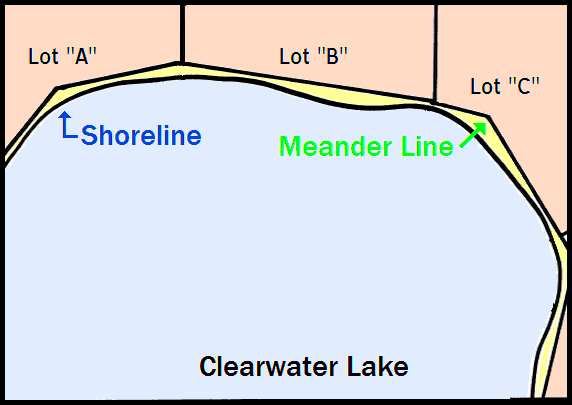Understanding Riparian Law in Michigan
Riparian law is a distinctive facet of property law that addresses the rights and obligations concerning bodies of water. To put it simply it regulates how landowners utilize and engage with the water that borders their land such as lakes, rivers and streams. This legal concept holds significance in Michigan, a state renowned for its plentiful water resources.
Riparian law is based on the idea of property rights that reach the waters edge. It guarantees that landowners can access and utilize the water but also imposes certain obligations. This legal framework finds a middle ground, between personal freedoms and societal concerns encouraging usage while safeguarding natural resources.
Key Principles of Riparian Rights in Michigan

In Michigan the concept of riparian rights hinges on a few key principles:
- Reasonable Use: Riparian landowners can use water from their property, but only in ways that are reasonable and do not harm other riparian users.
- Access to Water: Landowners have the right to access the water directly from their property. This includes activities like swimming, fishing, and boating.
- Natural Flow Protection: Landowners must avoid actions that would alter the natural flow of water or cause pollution.
- Sharing Water Resources: All riparian rights are subject to the principle of shared use, meaning no single user can dominate the water resource.
These guidelines guarantee a fair and equitable way of using water, showing great consideration for both personal property rights and the requirements of the community. Based on my observations grasping these principles is crucial for efficiently handling riparian land whether you are a homeowner or a builder.
How Riparian Rights Affect Property Ownership
Having land adjacent to a body of water in Michigan brings both advantages and obligations. Riparian rights grant property owners access to and utilization of water resources but they also come with restrictions.
For example you can partake in leisure pursuits such as fishing and boating but it’s important to make sure that your activities don’t infringe upon the rights of others. In a similar vein even though you may have the freedom to construct things like docks they shouldn’t hinder the movement of water or harm the ecosystem.
Based on my experience handling a riparian property requires thoughtful planning and a consideration of legal responsibilities and community impact. Property owners need to keep up to date with regulations and take action to resolve any issues that come up. Striking a between enjoying the property and fulfilling responsibilities is what makes owning riparian land both fulfilling and demanding.
Permitted Uses of Riparian Rights
Riparian rights offer property owners close to water bodies an array of opportunities. However these rights are accompanied by rules to maintain a balance in the enjoyment and utilization of water resources by all. It’s essential to grasp the limitations and freedoms that come with your riparian rights.
Here’s a look at some of the permitted uses:
- Recreational Activities: You’re free to swim, fish, or sail from your property. Enjoying the water is one of the key benefits of having riparian rights.
- Building Structures: Constructing docks, piers, and boathouses is allowed, but they must not obstruct water flow or affect other users’ rights.
- Water Extraction: Drawing water for personal use or irrigation is permitted, as long as it doesn’t adversely affect the water level or quality for others.
- Environmental Protection: You can engage in activities that support the natural habitat, such as planting vegetation along the shore to prevent erosion.
Based on what I’ve seen finding the right balance between having fun and being responsible is key when it comes to these rights. I’ve noticed that knowing the guidelines and talking to your neighbors can really help keep things smooth in terms of how we interact with nature and the people around us.
Disputes and Resolving Conflicts in Riparian Law
Even in states with well defined riparian laws such as Michigan property owners frequently find themselves in conflicts. These disagreements often stem from issues related to water resource usage or how changes made to one property affect adjacent lands.
Common sources of disputes include:
- Water Usage: Disagreements may occur if one property owner’s water use negatively affects the water levels or quality for others.
- Structure Placement: Issues can arise if a dock or pier extends too far or blocks access for others.
- Environmental Impact: Activities that harm the natural habitat or disrupt the flow of the water can lead to conflicts.
Addressing these conflicts usually involves a mix of discussions, mediation and occasionally taking legal measures. In my experience fostering communication and empathy can be very effective in settling disagreements. Involving a mediator or attorney can be a sensible move when issues prove to be more complex.
Regulations and Compliance for Riparian Property Owners
If you own land along the water in Michigan you have to follow some rules to safeguard the water and make sure everyone uses it fairly. Its important to stick to these regulations to steer clear of problems and keep things friendly with your neighbors and the natural surroundings.
Here’s a summary of key regulations:
- Permit Requirements: Certain activities, such as building docks or dredging, may require permits from local or state authorities.
- Environmental Protection: Property owners must comply with laws that protect water quality and natural habitats, including restrictions on pollution and erosion.
- Water Usage Limits: Regulations may specify limits on water withdrawal to prevent depletion or contamination.
- Maintenance of Structures: Regular maintenance of structures like docks and piers is required to ensure they do not pose hazards or obstruct water flow.
From what I’ve seen keeping up with local laws and getting involved with regulatory agencies can prevent problems and ensure that everything is in order. Its beneficial to spend time grasping these regulations since they aim to strike a balance between personal freedoms and safeguarding the environment.
Impact of Riparian Law on Land Development
The interplay between riparian law and land development is a balance for property owners and developers. Grasping this connection is essential for making choices. In Michigan where water bodies are plentiful riparian law plays a role in shaping the development of land adjacent to water.
Riparian law plays a role in shaping land development by governing the use of water bodies and their surrounding areas. It sets guidelines on how much water can be withdrawn from rivers or lakes and establishes requirements for protecting water quality and preserving ecosystems. These regulations can influence the location and design of new developments including residential, commercial or industrial projects. Developers need to consider factors such as proximity to water sources potential impacts on wildlife habitats and compliance with environmental standards when planning their projects. By balancing the needs of development with the preservation of water resources and ecosystems riparian law aims to ensure sustainable growth while safeguarding natural habitats.
- Permitted Construction: Developers must obtain permits for building near or over water. This includes docks, piers, and other structures. The goal is to prevent disruption of natural water flow and to avoid negative impacts on the ecosystem.
- Environmental Considerations: Development projects must consider environmental impacts, such as erosion control and water quality. For example, building regulations might require buffer zones of vegetation to prevent runoff from entering the water.
- Public Access: Riparian law often mandates that certain areas remain accessible to the public. This can affect how private land is developed, ensuring that community access to natural resources is preserved.
- Balancing Act: Developers need to balance the desire for property improvements with the need to protect natural resources. In my experience, this balance requires thoughtful planning and sometimes compromise to align with legal and environmental standards.
Having faced obstacles before I’ve come to realize that incorporating environmental and legal aspects right from the start can streamline the process and prevent issues down the road. It’s about fostering a balance between progress and the natural world.
Recent Changes in Riparian Law in Michigan
Over the years Michigans riparian law has adapted to tackle new environmental issues and meet the evolving needs of society. Keeping abreast of these updates is crucial for property owners and developers to ensure they adhere to regulations and make well informed choices.
Recent changes include:
- Enhanced Environmental Protection: New regulations focus on stricter controls to protect water quality and natural habitats. This includes tighter restrictions on pollutants and runoff.
- Increased Permit Requirements: There are now more comprehensive permit requirements for construction and modifications near water bodies. This aims to better manage the impact on riparian environments.
- Public Access Laws: Amendments to public access laws ensure greater community access to waterfronts, balancing private property rights with public interest.
- Innovative Management Practices: New practices are being introduced to manage water levels and mitigate the effects of climate change on water resources.
In my view these shifts demonstrate an increasing recognition of environmental concerns and the importance of responsible management. Staying informed about these developments has been crucial for efficiently and harmoniously overseeing riparian land.
Frequently Asked Questions
Navigating the intricacies of riparian law can be challenging, so its understandable to seek clarification. Below are some frequently asked questions along with their responses to address common concerns.
- What is a riparian right? Riparian rights are the legal entitlements of property owners whose land is adjacent to a water body. These rights allow them to use and access the water, subject to certain regulations and limitations.
- Do I need a permit for building a dock? Yes, in most cases, you will need a permit to build a dock or other structures on or near the water. The permit ensures that your construction complies with local regulations and environmental standards.
- Can I alter the flow of the water? Altering the natural flow of water is generally not permitted as it can impact neighboring properties and ecosystems. Any changes typically require approval from regulatory bodies.
- How do I resolve a dispute with a neighbor over riparian rights? Open communication is often the first step in resolving disputes. If issues persist, involving a mediator or legal professional may be necessary to reach a resolution.
These frequently asked questions tackle the issues I come across most frequently and I trust they shed light on riparian law. Keep in mind that its wise to seek counsel for matters.
Conclusion
Navigating the complexities of riparian law in Michigan involves a blend of legal insight and a genuine appreciation for our natural resources. It encompasses grasping the intricacies of riparian rights and responsibly managing land development. This branch of law demands both mindfulness and thoughtfulness. My own encounters with riparian matters have shown me that achieving success often hinges on finding a balance between enjoying waterfront properties and upholding environmental responsibility and legal adherence. Striking this equilibrium not ensures a living environment but also plays a role in safeguarding Michigans stunning water resources for generations to come. Staying updated fostering communication with neighbors and seeking guidance when necessary can enhance this journey, making it smoother and more fulfilling.


